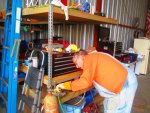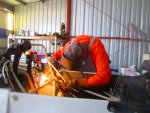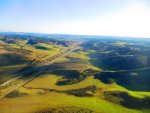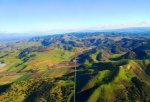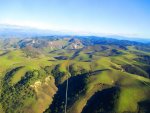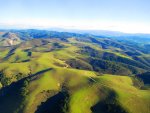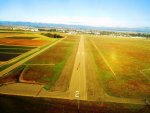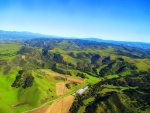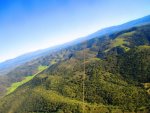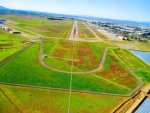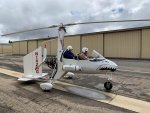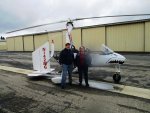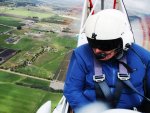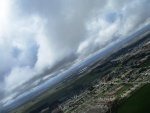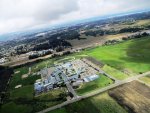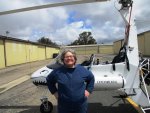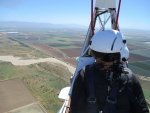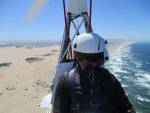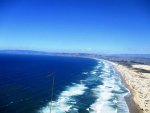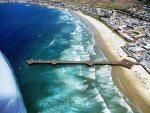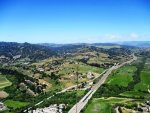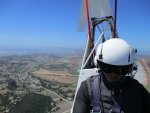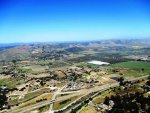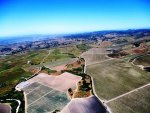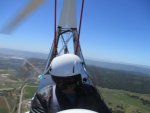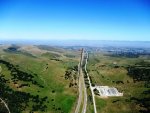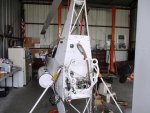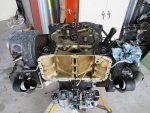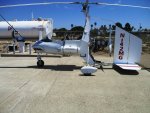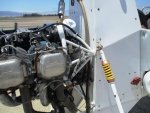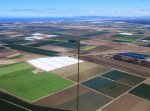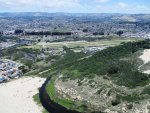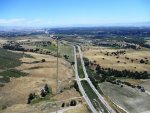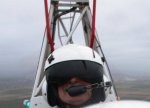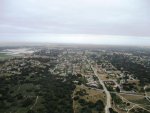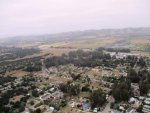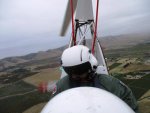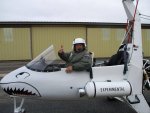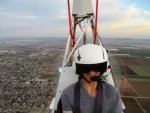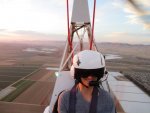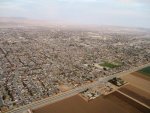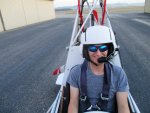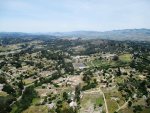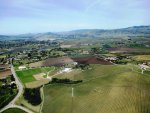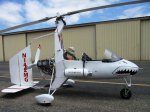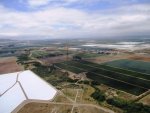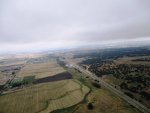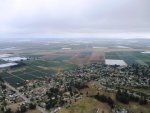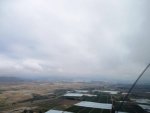I was just packing up the computer to head for the airport when the phone rang. A family Barbeque had surprised my client so he had to cancel today’s flight. I had been watching the weather to plan the lessons and it looked to me like a lovely day to fly. The wind was supposed to come up to 17kts around 2:00 as the aftermath of a storm that passed through here yesterday so I thought I would fly to San Luis Obispo (SBP) for lunch and be back to Santa Maria (SMX) before 2:00. For a primary student with his level of experience I figured we would stop flying around 2:00. I like to increase the winds as they gain experience because no matter how well they watch the weather they will one day need to land in some strong winds. He is at a maximum of 17kts at this time and I would like to spend more time at 13kts or less.
I took extra time on the preflight because of the recent extensive work on The Predator. I was pleased to see a reduction in oil leaks and every fastener I checked was secure. I had used less than a quart of oil in ten flight hours.
I called flight service and there was AIRMET Tango for moderate turbulence and AIRMET Sierra for limited visibility, low ceilings and mountain obscuration. Freezing levels were at 9,000 feet. Visibility was six miles at both SBP and SMX. VFR flight was not recommended along my route of flight. The forecast mirrored what I had seen on Weathermeister. There were no pilot reports locally and some pireps for icing a little further out.
My departure time slipped a little and I worked through the startup check list. She fired up at the first touch of the button despite the cold and quickly settled into an unsteady idle as I listened to the current ATIS. The wind was 290 degrees at nine knots gusting to eighteen knots. I listened to it three times because it did not agree with what I was seeing. On my taxi out I carefully watched all four wind socks and looked like more than nine knots but there was no evidence of gusts. As I taxied out the new ATIS came out with the wind at 290 degrees at twelve knots with no gusts reported.
After a good magneto check I pulled up to the hold short line, took a deep breath, found a break and said; “Santa Maria Tower, Experimental Gyroplane 142 Mike Golf, holding short of Runway three zero at Alpha Eight, ready for departure, request straight out with a slight left.” ATC was dealing with five aircraft and fit me in more quickly than I expected. “Experimental 142 Mike Golf, runway three zero clear for takeoff, straight out approved.” I love to hear those words because it is the beginning of another gyroplane flying adventure.
I talked myself through the takeoff as though I had a client with me. One hundred rotor rpm cyclic half back, one hundred twenty cyclic full back, one hundred eighty full power. The roll was short and she lifted off at 45kts and quickly reached 50kts of indicated air speed climbing out at over 900 feet per minute in the cool air.
At 750 feet I started pulling the power back and still went right past 800 feet (rotorcraft pattern altitude at SMX). Typical level flight would be around 2,100 engine rpm and I was down to 1,800 rpm and reached 1,200 feet before she stopped climbing.
As I was descending back toward eight hundred feet I suddenly dropped about 50 feet with a disquieting lurch. She continued to require power adjustments as I made my way across the Santa Maria Valley toward the shoreline. I tried to imagine how to explain what had just happened if it had happened with a client at the controls. I did not have a satisfactory response.
As many times as I have made this flight I still find magic in it. There are always unique challenges. I caught big lift as I approached the shoreline and again didn’t start to descend till I had her back to 1,800 rpm. I pulled her nose up and slowed to 20kts for a faster descent. The Predator felt at ease as I made a nose high low airspeed descending turn to 600 feet for my run up the shoreline and I made my first call to Oceano (L52). I have to admit I am more relaxed flying without a student.
The Pacific was a wonderful rich blue with the white water of the surf in sharp contrast. The feel of the cool ocean air on my face always fills me with joy and gratitude to be in a place where I can experience it. I love the way my view of the beach expands with a little altitude. I feel I am living may people’s dreams.
There were lots of campers on the beach and a surprising number of them waved at the strange craft flying over the shoreline. I waved back as often as I saw them.
There were three aircraft in the pattern at Oceano all making good radio calls as we rumbled by.
I reached the Pismo Pier and made my last call to L52 departing to the north, checked the ATIS for SBP and called the tower over Shell Beach at 700 feet. I was to make left traffic for runway two nine, report down wind and ident.
As I entered the Avilla Pass I found moderate turbulence that got stronger as I neared the airport. The wind sock was whipping through about forty degrees and the tower reported winds at two seven zero degrees at eighteen knots. There were seven aircraft in the pattern and when I reported midfield downwind I was to make a short approach. I made a descending carrier turn loving how easy to control The Predator is. As I finished up my round out I let her turn into the wind to two five zero degrees touching down as gently as could be at near zero ground speed on the centerline. I love the way a gyroplane manages wind.
I was greeted with three smiling faces and guided to a parking space next to the CHP Cessna as I struggled with the rotor. These men are familiar with me so they stayed well clear till I had the rotor stopped.
I made a pilot’s report to flight service for moderate turbulence within five miles south west of SBP at 1,300 feet and below
Lunch was great and I finished my preflight by 1:30. AIRMET Tango and Sierra were still in effect and ATIS had the winds at 320 degrees at 18kts gusting to 24kts. They were very busy and still got me off quickly ahead of a helicopter landing.
I decided to fly direct to SMX so I asked for a left downwind to the east with an early left turnout.
Rotor management was a little challenging on takeoff and I waited to see two hundred rotor rpm before adding full power. Climbing out of the Edna Valley is always a treat and I was seeing about a 20kt tail wind with lots of lift as I approached the hills with some sink on the lee side over Arroyo Grande. I paralleled California Highway 101. I was again busy with the throttle to maintain altitude.
As I let The Predator rock and roll I tried to remember the trepidation I used to feel when she would diverge from my chosen path. The temporary divergence causes most low time gyroplane pilots to over control stabbing at the cyclic with little effect.
The turbulence got worse as we flew over the Santa Maria Valley and ATIS had winds at 310 degrees at eighteen knots gusting to twenty eight knots. ATC told me to make a right down wind and report abeam. I heard several requests for wind checks before I reported and runway three zero was clear to land. All six windsocks I could see were blowing in different directions. I picked the one to the right of the runway near alpha four and just sort of let her settle down to gently caress the runway.
I reported moderate turbulence along the entire route from SBP to SMX at thirteen hundred feet to flight service. Pilot reports are becoming scarce as more and more people get their weather on a computer. I am still big on calling flight service because the briefers know more about the weather than I ever will.
Because of the strong winds I pushed her inside quickly and gave myself a formal debrief.
Good smooth control inputs on the cyclic, good airspeed control, good radio work, nice takeoffs and very nice landings. Altitude awareness and control need work. Better analysis of trends would help with this. Perhaps a little more aggressive throttle work would help. It is probably just as well nobody stopped by as I carried on both sides of the briefing
I love to fly and I love to teach. Thank you for coming along.

